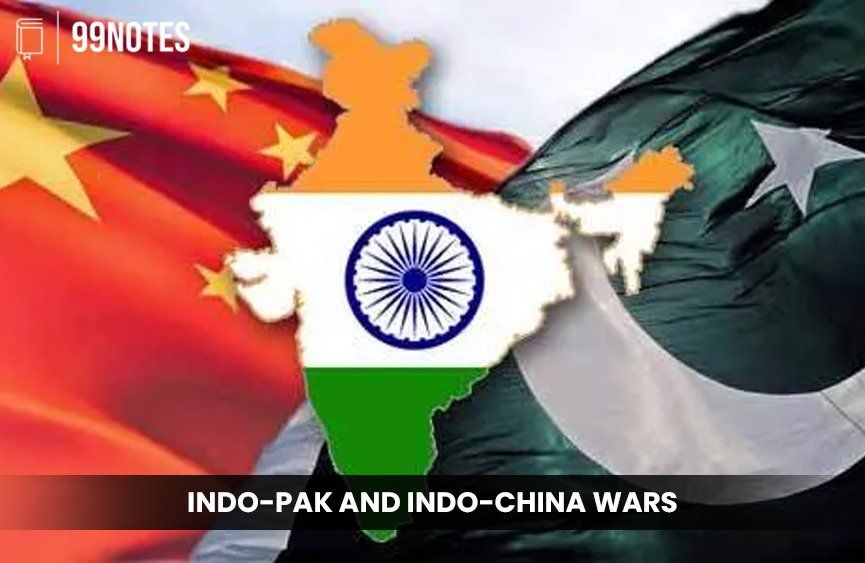INDO-PAK AND INDO-CHINA WARS
 India’s relations with its two immediate neighbours, Pakistan and China, have been marked by historical tensions, territorial disputes, and political complexities. Both countries, while sharing deep-rooted historical ties with India, have been at the centre of India’s foreign policy concerns due to conflicts over territorial boundaries, ideological differences, and strategic rivalries. These relations have not only shaped India’s security policies but also influenced its
India’s relations with its two immediate neighbours, Pakistan and China, have been marked by historical tensions, territorial disputes, and political complexities. Both countries, while sharing deep-rooted historical ties with India, have been at the centre of India’s foreign policy concerns due to conflicts over territorial boundaries, ideological differences, and strategic rivalries. These relations have not only shaped India’s security policies but also influenced itsPartition of India in 1947 led to the creation of Pakistan, marking the beginning of a strained relationship between the two nations. The Kashmir dispute became the central issue, diplomatic approaches and regional engagements.
Background
Pakistan: The leading to multiple wars in 1947-48, 1965, and 1971, and the ongoing political and military tension over the territory of Kashmir. Despite efforts at peace, the issue of cross-border terrorism and militant activities, particularly from Pakistan-based groups, has consistently derailed diplomatic efforts.
China: India’s relationship with China has also been fraught with challenges. The border conflict between the two nations, especially over the Aksai Chin region (in the Ladakh area) and Arunachal Pradesh, led to the 1962 Indo-China War. Though diplomatic relations were restored in the 1970s and have seen periods of cooperation, recent years have witnessed renewed tensions, especially along the Line of Actual Control (LAC), as evidenced by the Galwan Valley clash in 2020.
Causes of Recurring Conflicts and Territorial Disputes
The persistent conflicts and territorial disputes between India, Pakistan, and China stem from a combination of historical, political, and strategic factors:
- Partition and Kashmir: The most significant issue in India-Pakistan relations remains the dispute over Kashmir. Both countries claim the region in full but administer parts of it, leading to numerous military conflicts and continued hostility. The Line of Control (LoC) dividing Kashmir remains a flashpoint for tensions.
- Territorial Claims: With China, the Aksai Chin region and the border in Arunachal Pradesh have been contentious. China’s occupation of Aksai Chin during the 1962 war and its continued claim over Arunachal Pradesh are major sources of conflict. Despite numerous rounds of talks, an agreement on the border issue remains elusive.
- Ideological Differences: The ideological divide between India and Pakistan, rooted in their religious and cultural differences, has exacerbated the tension. Pakistan’s identity as an Islamic state and its role in advocating for the rights of Muslims in Kashmir remains a contentious point with India, which perceives Pakistan’s stance as an interference in its internal affairs.
- Strategic Rivalries and Military Build-up: Both Pakistan and China’s military capabilities and strategic alliances have further complicated their relations with India. Pakistan’s close ties with China, particularly in military cooperation and economic investments (such as the China-Pakistan Economic Corridor, CPEC), have raised concerns in India. China’s growing influence in South Asia and its assertive stance in the Indo-Pacific region also directly challenge India’s regional dominance.
These recurring issues have not only hindered bilateral ties with Pakistan and China but have also influenced India’s approach to regional security, diplomacy, and defence strategy. As tensions continue, India’s foreign policy toward both nations remains centred around strategic defence, diplomatic negotiations, and efforts to safeguard national interests while promoting regional stability.
Indo-Pak Wars
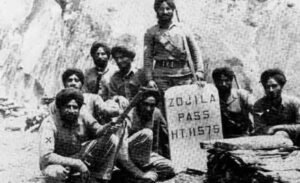 The Indo-Pak Wars stem from the deep-rooted territorial and political conflict between India and Pakistan since their partition in 1947. The primary point of contention has been the Kashmir issue, which has triggered multiple wars and skirmishes. These conflicts have significantly influenced the geopolitical dynamics of South Asia.
The Indo-Pak Wars stem from the deep-rooted territorial and political conflict between India and Pakistan since their partition in 1947. The primary point of contention has been the Kashmir issue, which has triggered multiple wars and skirmishes. These conflicts have significantly influenced the geopolitical dynamics of South Asia.
1. First Indo-Pak War (1947–48)
The First Indo-Pak War (1947–48) was the first major conflict between India and Pakistan after the Partition, fought over the princely state of Jammu and Kashmir. It shaped the Kashmir dispute and laid the foundation for future conflicts between the two nations.
Background: After Partition, princely states were given the option to join India, Pakistan, or remain independent. Jammu and Kashmir, a Muslim-majority state ruled by Hindu Maharaja Hari Singh, sought to remain independent initially. Pakistan claimed Kashmir based on its Muslim-majority population, leading to tensions.
Causes
- Political Uncertainty: Uncertainty over Kashmir’s accession created tensions between India and Pakistan.
- Tribal Invasion: In October 1947, tribal forces from Pakistan’s North-West Frontier Province (NWFP), backed by Pakistan, invaded Kashmir.
- Accession to India: Facing invasion, Maharaja Hari Singh signed the Instrument of Accession with India on October 26, 1947, seeking military assistance.
Events
- Initial Pakistani Gains: Pakistani-backed tribal forces quickly captured large parts of Kashmir, including Muzaffarabad and Baramulla.
- Indian Military Intervention: On October 27, 1947, Indian troops landed in Srinagar and launched a counteroffensive, pushing back the invaders.
- Battle of Budgam (October 27, 1947): Indian forces secured the Srinagar airfield and repelled the tribal attack.
- Battle of Zoji La (November 1948): Indian forces used tanks at high altitudes, recapturing key strategic positions.
- Siege of Poonch and Rajouri: Indian forces engaged in prolonged battles to secure these areas from Pakistani control.
- United Nations (UN) Intervention: The UN brokered a ceasefire in December 1948, leading to the establishment of the Line of Control (LoC).
Outcome
- Ceasefire and LoC: The war ended with a UN-mediated ceasefire in December 1948, resulting in the creation of the Line of Control (LoC).
- Division of Kashmir: The ceasefire left Jammu and Kashmir divided between Indian-administered Jammu & Kashmir and Pakistani-administered Azad Kashmir.
- Ongoing Dispute: Both nations claimed the entire Kashmir region, leading to further conflicts and diplomatic tensions.
- Displacement and Casualties: The war caused the displacement of thousands of civilians and significant military casualties on both sides.
- Foundation for Future Conflicts: The Kashmir issue remained unresolved, contributing to future wars and ongoing tensions between India and Pakistan.
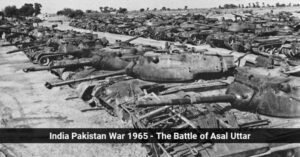 2. Second Indo-Pak War (1965)
2. Second Indo-Pak War (1965)
The Second Indo-Pak War occurred in 1965 and was primarily triggered by the Kashmir issue, with Pakistan launching Operation Gibraltar to infiltrate Indian-administered Kashmir. This conflict escalated into full-scale warfare between the two nations.
Cause
- The immediate cause of the war was Pakistan’s Operation Gibraltar in Kashmir. Pakistan aimed to infiltrate and support insurgents in Jammu and Kashmir, hoping to provoke an uprising and annex the region.
- The operation led to India launching a counter-offensive in Kashmir, which resulted in intense fighting along the Line of Control (LoC).
- The war was exacerbated by Pakistan’s desire to take advantage of the perceived weakness of India following the Sino-Indian War of 1962, and the rising tensions in the region over Kashmir.
Events
- The war saw large-scale battles, with tank warfare dominating the ground operations, especially in areas such as Chhamb and Akhnur.
- Air warfare also played a significant role, with both countries employing their respective air forces in bombing runs and air combat.
- The conflict witnessed heavy casualties on both sides, with cities and military installations being targeted.
- The war expanded beyond Kashmir and spread into the Punjab region, where both nations fought fierce battles.
- The Tashkent Agreement, brokered by the Soviet Union, was signed in January 1966 to bring the war to a halt. Indian Prime Minister Lal Bahadur Shastri and Pakistani President Ayub Khan signed the agreement, with both countries agreeing to return to the pre-war positions and to refrain from further hostilities.
Outcome
- The war ended with no territorial changes and the status quo being maintained along the LoC.
- Despite heavy losses on both sides, the conflict did not result in a decisive military victory for either nation.
- The Tashkent Agreement restored peace, but it failed to resolve the underlying Kashmir issue, and the situation remained tense. Both India and Pakistan retained control over their respective regions of Kashmir, but the territorial dispute remained unresolved.
- The war and its aftermath also played a crucial role in shaping future India-Pakistan relations and their military strategies.
| Tashkent Agreement (1966) (PYQ 2013) |
|
The Tashkent Agreement was signed on January 10, 1966, between India and Pakistan under the mediation of the Soviet Union. It aimed to restore peace after the Indo-Pakistan War of 1965, which resulted in heavy casualties and political tensions. The agreement marked a significant diplomatic effort to ease hostilities between the two nations and establish a framework for future peace. 1. Circumstances Leading to the Tashkent Agreement
2. Highlights of the Tashkent Agreement
3. Impact and Criticism
The Tashkent Agreement was a significant diplomatic effort that temporarily restored peace between India and Pakistan. However, the agreement failed to address the core issue of Kashmir, leading to renewed tensions and future conflicts. |
3. Third Indo-Pak War (1971)
The Third Indo-Pak War of 1971 was a pivotal moment in the history of South Asia, marking the creation of the independent state of Bangladesh and altering the geopolitical landscape of the region. The war, fought between India and Pakistan, was rooted in the political unrest and violence in East Pakistan, which ultimately led to India’s military intervention to support the Bengali independence movement. The war had far-reaching consequences for both India and Pakistan, and it also played a key role in strengthening India’s position in the global arena.
Cause: By 1970, Pakistan was facing significant internal unrest due to the political and economic disparities between East and West Pakistan. The Awami League, led by Sheikh Mujibur Rahman, won a landslide victory in East Pakistan’s 1970 elections, but the Pakistani military, led by General Yahya Khan, refused to transfer power.
- In March 1971, the Pakistani military launched Operation Searchlight to suppress the political movement in East Pakistan, resulting in widespread violence and a refugee crisis. On March 26, 1971, Sheikh Mujibur Rahman declared East Pakistan’s independence, initiating the Bangladesh Liberation War.
Events: India initially supported the Bengali independence movement diplomatically and provided humanitarian assistance to refugees. As the situation worsened, India decided to intervene militarily to help the Bengali people.
- On December 3, 1971, Pakistan launched an airstrike on Indian airbases, prompting India to declare war. The war was fought primarily in East Pakistan, with India mobilizing its military forces along with the Mukti Bahini (Bangladeshi liberation forces).
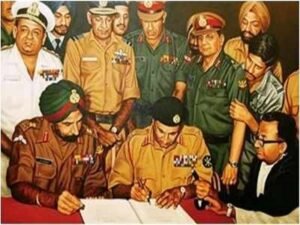 India’s strategy included a coordinated attack, swift military progress, and the capture of key territories in East Pakistan.
India’s strategy included a coordinated attack, swift military progress, and the capture of key territories in East Pakistan.- The Indian Navy imposed a naval blockade on Pakistan, cutting off vital supply lines.
- On the Western Front, Indian forces pushed back Pakistani troops and secured strategic positions.
- After intense fighting, Pakistani forces in East Pakistan were forced to surrender on December 16, 1971, with approximately 93,000 soldiers and civilians taken as prisoners of war. This marked the end of the war and the beginning of Bangladesh’s journey as an independent state.
Outcome
- The creation of Bangladesh as an independent nation was the key outcome of the war. Sheikh Mujibur Rahman became the first Prime Minister of Bangladesh.
- The war also led to a significant weakening of Pakistan, both militarily and politically, and further exacerbated the internal instability within the country.
- India’s victory in the war was supported by the Indo-Soviet Treaty of Peace, Friendship, and Cooperation, signed in August 1971. This treaty provided India with diplomatic and military support from the Soviet Union, which was crucial in countering the United States’ backing of Pakistan during the Cold War.
- The victory in 1971 cemented India’s position as a regional power, while Bangladesh’s independence was a triumph for the people of East Pakistan who had endured immense suffering.
| Shimla Agreement |
|
The Shimla Agreement was signed on July 2, 1972, between India and Pakistan to restore peace and diplomatic relations after the 1971 Indo-Pak war. It aimed to promote bilateral discussions and peaceful conflict resolution, particularly concerning Kashmir.
Despite its intent, the agreement failed to prevent future conflicts, as seen in Kargil (1999). However, it remains a crucial diplomatic framework for India-Pakistan relations. |
The Third Indo-Pak War was a defining moment in South Asian history. India’s decisive military intervention not only led to the creation of Bangladesh but also reinforced India’s strategic and diplomatic ties with the Soviet Union. The war had profound implications for the future of India, Pakistan, and Bangladesh, reshaping the political dynamics in the region and establishing India as a key player in global geopolitics.
| India’s Role in Bangladesh Liberation (PYQ 2013) |
|
The emergence of Bangladesh in 1971 was a result of political, humanitarian, and strategic compulsions that prompted India to intervene decisively in the East Pakistan crisis.
India’s decisive role in the emergence of Bangladesh was driven by a combination of political, humanitarian, and strategic factors. The successful intervention not only resolved an immediate crisis but also established India as a key regional power in South Asia. |
 Kargil Conflict (1999)
Kargil Conflict (1999)
The Kargil Conflict of 1999 was a significant military confrontation between India and Pakistan, which took place in the Kargil district of Jammu and Kashmir. The conflict was characterized by the infiltration of Pakistani forces and militants into Indian territory along the Line of Control (LoC). It was a unique war fought at high altitudes in difficult terrain and played a crucial role in shaping the future of India-Pakistan relations, as well as strengthening India’s security strategies.
Cause
- In early 1999, Pakistani forces and militants infiltrated the Kargil district of Jammu and Kashmir, occupying strategic positions on Indian territory. This was a direct violation of the Line of Control (LoC), which had been established as the de facto boundary between India and Pakistan after the 1972 Shimla Agreement.
- Pakistan’s strategy was to gain control of the area and use it as leverage in future negotiations over Kashmir. The intruders established military posts on high mountain peaks, which were critical for India’s defence and control of the region.
- The infiltration was initially unnoticed by Indian authorities, but it came to light when Indian troops began patrolling the area and clashed with the infiltrators.
Events
- Once the infiltration was detected, India launched Operation Vijay to reclaim the territory. The Indian Army, aided by the Indian Air Force, launched a series of military operations to dislodge the Pakistani forces from the high-altitude positions they had occupied.
- The conflict was fought under extremely challenging conditions, with Indian forces having to contend with rugged mountainous terrain, extreme weather, and high altitudes.
- The Indian military focused on recapturing strategic peaks and bunkers. Heavy artillery and airstrikes were used to neutralize the entrenched Pakistani positions.
- The Kargil War saw the participation of both regular Pakistani Army personnel and militants, which blurred the lines between conventional warfare and insurgency.
- The international community, including the United States, Russia, and other Western nations, strongly condemned Pakistan’s actions, urging it to withdraw its forces. The U.S., in particular, played a pivotal role in pressuring Pakistan to retreat, citing the violation of international norms.
Outcome: After several weeks of intense fighting, the Indian Army successfully recaptured all the high-altitude peaks occupied by Pakistani forces. By the end of July 1999, the conflict was effectively over, and Pakistan had no choice but to retreat.
- The Kargil Conflict resulted in significant military and civilian casualties on both sides. India lost more than 500 soldiers, while Pakistan’s casualties were also considerable.
- The outcome of the war reinforced India’s resolve to protect its territorial integrity, and the Kargil War became a symbol of the country’s military determination.
- The conflict highlighted the vulnerability of the LoC and prompted India to strengthen its border security, particularly in the Kargil region, through increased military presence and enhanced surveillance.
- The Kargil War also reinforced India’s stance on Kashmir, making it clear that any attempt to alter the status quo through military aggression would be met with strong resistance.
The Kargil Conflict was a significant chapter in the history of India-Pakistan relations, highlighting the risks of escalation and the importance of maintaining robust border security. The Indian military’s success in repelling the Pakistani forces demonstrated the country’s resolve to defend its territory, and it had a lasting impact on India’s defense and foreign policy strategies.
Indo-China War (1962)
The Indo-China War of 1962 was a pivotal conflict in the history of India’s foreign policy and military strategy. The war was primarily driven by unresolved border disputes between India and China, particularly over the regions of Aksai Chin and Arunachal Pradesh. It led to significant political and military consequences for India, and its impact continues to shape India-China relations to this day.
Cause: The root cause of the war lay in the territorial dispute between India and China over the border areas of Aksai Chin (which lies in the Ladakh region) and Arunachal Pradesh (formerly known as the North-East Frontier Agency). Both sides claimed these areas as their own, leading to tensions.
- Aksai Chin was of particular strategic importance to China as it connected Tibet with Xinjiang. India, however, considered it a part of its territory. Arunachal Pradesh, on the other hand, was claimed by China as part of its larger claim over the northeastern region, which it considered historically part of Tibet.
- In 1959, the Chinese government had begun constructing a road through Aksai Chin, which India viewed as an infringement on its territorial integrity.
- Diplomatic negotiations failed, and in 1962, China launched a large-scale military offensive along both fronts—Aksai Chin and Arunachal Pradesh—forcing India to fight a defensive war.
Events: On October 20, 1962, Chinese forces launched an unexpected invasion across the disputed border. China initially attacked the northeastern region of Arunachal Pradesh, followed by a major assault in the Aksai Chin area.
- India was caught off guard, with its military unprepared for a major confrontation. The Indian Army lacked the necessary resources, modern weaponry, and proper intelligence about China’s intentions.
- Chinese forces quickly overran several border posts in Arunachal Pradesh and advanced towards the heart of the region. The Indian military faced serious setbacks due to inadequate supply lines, poor infrastructure in the harsh Himalayan terrain, and the surprise nature of the attack.
- In the Aksai Chin region, Chinese forces successfully captured the strategically important area, which India had long claimed as part of its territory. The Indian military, despite its efforts, was unable to hold its ground in both regions.
Outcome: After intense fighting for about a month, India’s military was forced to retreat in both Arunachal Pradesh and Aksai Chin due to the overwhelming strength of the Chinese forces. A ceasefire was declared on November 21, 1962, following a unilateral announcement by China.
- As a result of the war, China retained control of Aksai Chin, which remains a part of its Xinjiang province today. While India maintained its claim over the region, it was unable to regain control of the territory.
- The conflict exposed India’s military vulnerabilities and its lack of preparedness for such a high-intensity war. In response, India made significant reforms in its defence sector, strengthening its military capabilities and focusing on improving border infrastructure.
- On the diplomatic front, the war strained India-China relations and led to a long-standing rivalry between the two nations, with both countries continuing to engage in periodic border skirmishes and disputes.
The Indo-China War of 1962 was a major turning point in India’s history, not only because of the military defeat but also due to its long-term impact on India’s defence policies and foreign relations. The war highlighted the importance of preparedness, border security, and diplomacy in managing territorial disputes. It also served as a reminder of the complexities of India’s relations with its neighbours, particularly China, and has influenced India’s approach to its defence and foreign policy ever since.
Post-1962 Border Clashes and Tensions
Following the 1962 Indo-China war, India and China have witnessed various clashes and standoffs along their shared border. Despite the ceasefire in 1962, tensions remained high due to unresolved territorial disputes, strategic interests, and conflicting perceptions of the border. These tensions manifested in several border clashes and military face-offs over the decades, including significant confrontations at Nathu La and Cho La in 1967, the Doklam standoff in 2017, and the Galwan Valley clash in 2020. These incidents have played a major role in shaping the contemporary India-China relations.
Nathu La and Cho La Clashes (1967)
- In 1967, nearly five years after the 1962 war, hostilities erupted again in the Nathu La and Cho La areas in Sikkim, which was then a protectorate of India (Sikkim became a state of India in 1975).
- The clashes occurred as a result of border tensions following a series of skirmishes between the Indian and Chinese military forces. The Chinese attempted to assert control over the Nathu La Pass, which was a strategically important route linking Tibet and India.
- The Nathu La clash began when the Chinese forces tried to push Indian forces away from their posts, but the Indian Army, better prepared and equipped compared to the 1962 war, successfully repelled the Chinese attacks.
- Following this, a similar skirmish occurred at Cho La, where Indian troops again faced the Chinese forces and pushed them back. The incidents led to significant casualties on both sides, but India’s defence proved to be resilient.
- Despite the military face-off, both nations avoided a full-scale war. However, the skirmishes underscored the persistent border tensions and the need for stronger border security and defence preparedness.
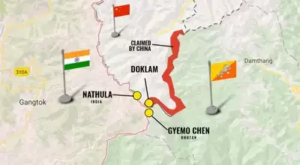 Doklam Standoff (2017)
Doklam Standoff (2017)
- The Doklam standoff occurred in 2017, when Chinese troops began constructing a road through the disputed Doklam plateau, located at the trijunction of India, China, and Bhutan.
- Bhutan, which claims Doklam as part of its territory, opposed the road construction, as it violated Bhutan’s sovereignty. India, in its capacity as a close ally of Bhutan, intervened, citing security concerns over the proximity of the Chinese road construction to India’s narrow “chicken’s neck” corridor, which connects the northeastern states of India to the rest of the country.
- The Indian Army deployed troops to the area to stop the road construction, leading to a tense military standoff between Indian and Chinese forces. The face-off lasted for several weeks, with both sides engaging in negotiations through diplomatic channels.
- The standoff ended after diplomatic efforts from both sides, and China eventually halted its road construction. The resolution of the Doklam crisis highlighted the importance of regional security dynamics and India’s commitment to protecting its strategic interests and its allies’ sovereignty.
Galwan Valley Clash (2020)
- The Galwan Valley clash occurred in June 2020 in the Ladakh region along the Line of Actual Control (LAC) between India and China. This confrontation was the deadliest in decades, marking a significant escalation in the border tensions between the two countries.
- The clash took place as Chinese troops attempted to change the status quo in the Galwan Valley area. India strongly opposed this, leading to violent face-offs between Indian and Chinese forces.
 Unlike previous clashes, this confrontation involved hand-to-hand combat, the use of makeshift weapons like stones and clubs, and the tragic deaths of 20 Indian soldiers, including a commanding officer. Chinese casualties were reported but not officially confirmed.
Unlike previous clashes, this confrontation involved hand-to-hand combat, the use of makeshift weapons like stones and clubs, and the tragic deaths of 20 Indian soldiers, including a commanding officer. Chinese casualties were reported but not officially confirmed.- The Galwan Valley clash marked a sharp escalation in the military standoff and led to widespread international condemnation of China’s actions. India’s response emphasized strengthening its defence preparedness and securing the region.
- The conflict led to significant diplomatic and military disengagement efforts, but tensions remained high, with both nations engaging in extensive negotiations and military talks. The clash further solidified India’s resolve to bolster its military capabilities along the LAC and strengthen its alliances in the region.
The post-1962 period has witnessed a series of border clashes and standoffs between India and China, ranging from the Nathu La and Cho La skirmishes in 1967 to the more recent Doklam standoff and Galwan Valley clash. These incidents highlight the ongoing border tensions between the two nations, driven by unresolved territorial disputes and strategic interests. While diplomatic efforts have helped de-escalate some of these situations, the security challenges at the India-China border remain a critical issue in India’s foreign policy and defence strategy.
Comparison of Indo-Pak and Indo-China Conflicts
India’s relations with Pakistan and China have been defined by conflicts that, though both centred around territorial disputes, differ significantly in terms of their nature, scale, and diplomatic outcomes. The Indo-Pak and Indo-China conflicts are two distinct strands of India’s security history, with the former largely involving conventional wars and the latter characterized more by border skirmishes and standoffs.
| Aspect | Indo-Pak Conflicts | Indo-China Conflicts |
| Primary Cause | Kashmir dispute and religious-political tensions post-Partition | Border disputes along the Line of Actual Control (LAC) |
| Major Wars | First War (1947–48), Second War (1965), Third War (1971), Kargil Conflict (1999) | Sino-Indian War (1962), Doklam Standoff (2017), Galwan Valley Clash (2020) |
| Nature of Conflict | Military confrontations, insurgency support, and territorial claims over Kashmir | Border skirmishes, military standoffs, and territorial disputes |
| Resolution Efforts | Tashkent Agreement (1966), Shimla Agreement (1972), Lahore Declaration (1999) | Border talks, diplomatic negotiations, and disengagement agreements |
| Current Status | Kashmir dispute remains unresolved; occasional ceasefire violations | Ongoing border tensions; military buildup and diplomatic negotiations |
Conclusion
India’s conflicts with Pakistan and China have significantly influenced its defence strategy and foreign policy, underscoring the importance of military strength and diplomatic engagement. The unresolved territorial disputes, especially in Kashmir and along the China border, pose ongoing security challenges that require a balance of military preparedness and diplomatic dialogue to prevent escalation and ensure national security.
Strategic partnerships with major powers like the United States and Russia, along with active participation in forums like BRICS, QUAD, and SCO, strengthen India’s position in addressing these disputes. By combining military readiness with strategic diplomacy, India can work toward long-term peace and regional stability while safeguarding its territorial integrity.
Related FAQs of INDO-PAK AND INDO-CHINA WARS
India’s ties with Pakistan and China are shaped by historical grievances, unresolved territorial disputes, and security concerns. With Pakistan, the main issue is the Kashmir dispute and cross-border terrorism. With China, the conflict centers around border disagreements, especially in Aksai Chin and Arunachal Pradesh. These tensions have led to multiple wars, military standoffs, and diplomatic complexities.
India has fought four major conflicts with Pakistan: the First War (1947–48) over Kashmir, the Second War (1965) due to Operation Gibraltar, the Third War (1971) which led to the creation of Bangladesh, and the Kargil Conflict (1999), involving infiltration in Kargil. Each war reinforced the significance of Kashmir and shaped Indo-Pakistani diplomatic and military strategies.
The 1962 Indo-China War stemmed from border disputes in Aksai Chin and Arunachal Pradesh. China launched a surprise invasion, and India, underprepared, suffered a defeat. The war exposed India’s military vulnerabilities, led to defence reforms, and initiated a prolonged period of strained India-China relations, with unresolved boundary issues persisting today.
In June 2020, Indian and Chinese troops clashed in the Galwan Valley in Ladakh over Chinese attempts to alter the status quo at the Line of Actual Control (LAC). The clash resulted in the deaths of 20 Indian soldiers and unknown Chinese casualties. It marked a significant escalation in Indo-China tensions and led to increased military deployments and prolonged disengagement talks.
Indo-Pak conflicts are primarily driven by the Kashmir issue, religious-political tensions, and involve full-scale wars and insurgencies. Indo-China conflicts, however, revolve around boundary disputes and are typically limited to standoffs and skirmishes. India-Pakistan efforts include peace accords like the Shimla Agreement, while India-China relations involve ongoing border talks and military disengagements.

